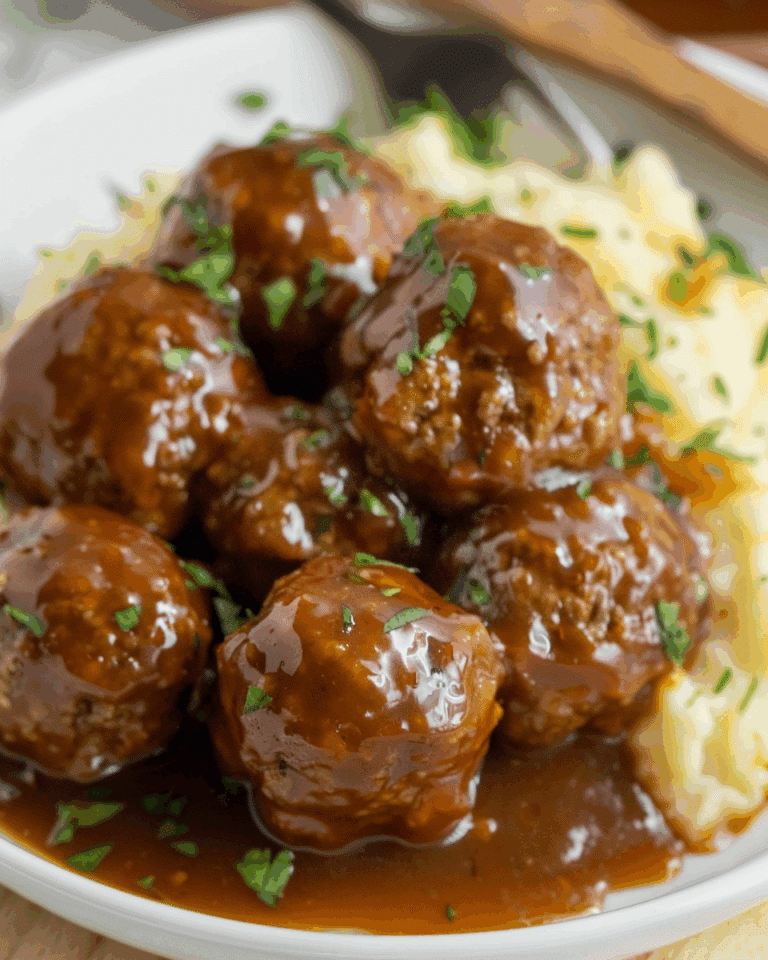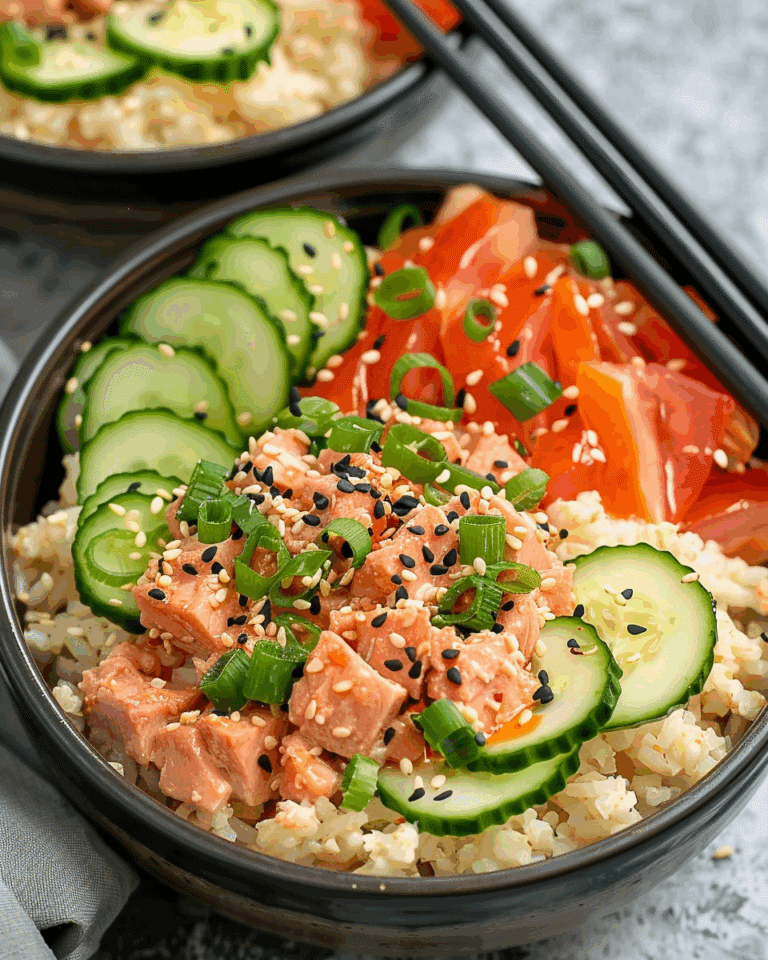If you’re craving a vibrant, comforting meal that brims with fresh, zesty flavors, look no further than this Thai Ginger and Garlic Noodle Bowl Recipe. It’s a beautiful harmony of tender noodles, crisp vegetables, and a mouthwatering sauce infused with fragrant ginger and garlic. What really makes this dish sing is how each ingredient plays its part perfectly, whether it’s the snap of snow peas, the earthy bite of shiitake mushrooms, or that subtle hint of lime that ties everything together. It’s not only bursting with flavor but also wonderfully satisfying and bright — a true celebration of Thai-inspired cooking that you’ll want to make again and again.
Ingredients You’ll Need
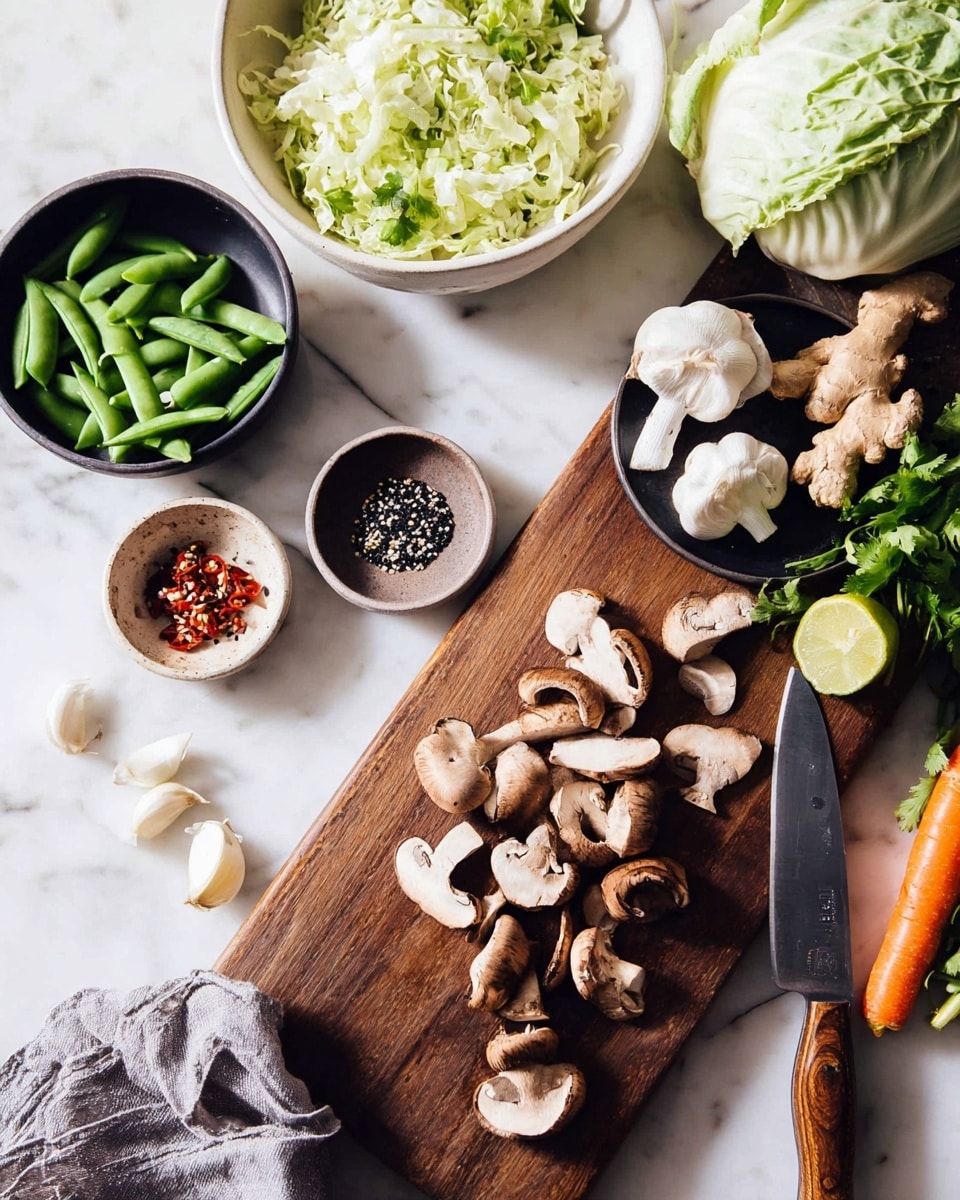
Simple, fresh, and full of character, the ingredients for this recipe each bring something special to the bowl. From the chewy texture of rice noodles to the sweet crunch of carrots and the umami depth of shiitake mushrooms, every component contributes to an unforgettable bite.
- Rice Noodles or Bean Thread Noodles (8 oz / 227g): These form the silky base that soaks up all those delicious sauce flavors.
- Snow peas (11 oz / 310g, trimmed): Adds a fresh snap and a burst of green color to brighten the dish.
- Sesame Oil (1 ½ Tbs + 1 Tbs): Gives a rich, nutty aroma and keeps everything luscious and lightly coated.
- Fresh Ginger (2 tsp, microplaned): Zesty and warming, ginger is the soul of this noodle bowl’s flavor profile.
- Fresh Garlic (1 Tbs, microplaned or minced): Adds a punch of savory depth that complements the ginger beautifully.
- Carrots (1 ½ C / 150g, julienned): Their natural sweetness and crunch balance the earthier elements.
- Green Cabbage (5 C / 400g, bite-sized pieces): Light and slightly sweet, it builds wonderful texture.
- Shiitake Mushrooms (5 oz / 142g, stemmed and quartered): Brings umami richness; cremini mushrooms are a fine substitute.
- Lime (½): Brightens and livens the whole dish with a refreshing citrus kick.
- Vegetable Broth (½ C / 110g): The base of the sauce that ties the savory and sweet elements together.
- Tamari (2 Tbs): A gluten-free soy alternative that deepens the salty flavor without overpowering.
- Coconut Sugar (1 Tbs): Adds subtle sweetness—brown sugar or maple syrup work well, too.
- Red Pepper Flakes (½ tsp): Provide a gentle heat that wakes up the palate.
- Sea Salt (½ tsp): Enhances all the natural flavors perfectly.
- Scallions (thinly sliced): Sprinkle on top for freshness and color.
- Sesame Seeds: Toasted for crunch and a nutty finish.
- Thai Basil (or mint/cilantro): The aromatic herb that adds that signature Southeast Asian flair.
- Additional Tamari and Sesame Oil: For drizzling and extra flavor at serving time.
- Lime Wedges: To squeeze on just before enjoying.
How to Make Thai Ginger and Garlic Noodle Bowl Recipe
Step 1: Prepare the Noodles
Start by placing your rice or bean thread noodles in a large bowl filled with cold water. Let them soak while you prep the veggies and whip up the sauce. Soaking in cold water is key here—it softens the noodles gently without turning them into a mushy mess, which sometimes happens with hot water soaking.
Step 2: Blanch the Snow Peas
Bring a large pot of water to a boil and prepare your snow peas by trimming the ends. Blanch the peas in boiling water for exactly two minutes to keep their beautiful bright green color and crisp texture. Then, drain and rinse them right away with cold water. Toss them back into the pot to keep warm until you’re ready to assemble.
Step 3: Make the Sauce
In a small jar or bowl, combine the vegetable broth, 1 tablespoon of sesame oil, tamari, coconut sugar, red pepper flakes, and sea salt. Give it a good shake or stir until everything is well mixed, then set aside. This simple sauce is bursting with balance—sweet, salty, spicy, and savory all at once.
Step 4: Stir-Fry the Veggies
Heat 1 ½ tablespoons of sesame oil over medium-high heat in a wok or large skillet until shimmering. Toss in the microplaned ginger and garlic and let them sizzle just until fragrant, about 30 seconds. Next, add mushrooms, cabbage, and carrots and stir-fry for 5 to 6 minutes until the veggies are tender-crisp. This step is where those wonderful textures and flavors develop beautifully. Transfer these cooked vegetables into the pot with your snow peas and turn the heat off to keep everything warm.
Step 5: Finish the Noodles
Drain your soaked noodles thoroughly and set them near the stove. In the same skillet you cooked the veggies in, pour in your pre-mixed sauce and bring it to a gentle simmer. Add the noodles and use tongs to toss them around thoroughly so each strand absorbs that savory sauce. Lower the heat and continue stirring for about 2 minutes, checking for tenderness. If the noodles feel too firm, give them a bit more time to soften. Once perfect, remove from heat and fold in the cooked vegetables to warm through gently. Finish with a squeeze of lime juice to bring a lively brightness to the whole bowl.
How to Serve Thai Ginger and Garlic Noodle Bowl Recipe
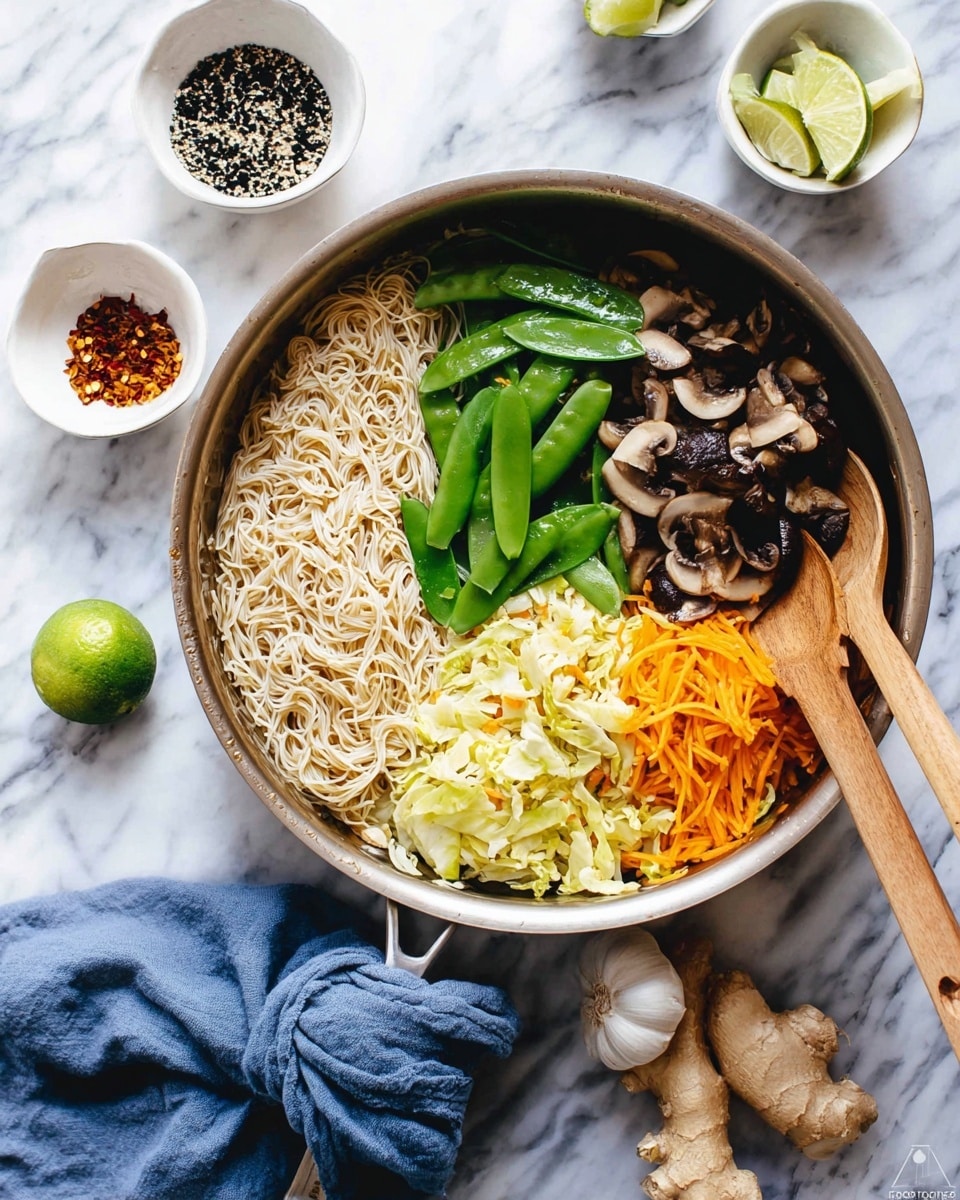
Garnishes
This dish really shines when topped off with some thoughtful garnishes. Sprinkle toasted sesame seeds for a delightful crunch, scatter thinly sliced scallions to add sharp freshness, and tuck in fragrant Thai basil leaves for that authentic, herby lift. A drizzle of extra tamari or sesame oil can deepen the flavor even more, while lime wedges on the side invite your guests to add their own zing.
Side Dishes
The Thai Ginger and Garlic Noodle Bowl Recipe stands splendidly on its own, but it pairs beautifully with lighter sides to round out the meal. Consider serving a crisp cucumber salad with a tangy dressing or simple steamed dumplings to complement the vibrant flavors. A light soup like tom yum or a fresh papaya salad would also balance the hearty noodles with refreshing notes.
Creative Ways to Present
For a stunning presentation, serve the noodle bowl in individual deep bowls to hold the generous mix of noodles and veggies. Layer the garnishes artistically on top—nestle some basil leaves here, scatter sesame seeds there, and place lime wedges off to the side. If you want to get creative, wrap the noodles and veggies in fresh lettuce leaves for a fun hands-on experience that guests will love.
Make Ahead and Storage
Storing Leftovers
While this noodle bowl is best enjoyed fresh to maintain the integrity of the noodles and crunch of the vegetables, leftovers can be stored properly in an airtight container in the refrigerator for up to three days. Keep in mind that the noodles will soften and absorb more sauce as they sit.
Freezing
Freezing this dish is not recommended because the texture of the noodles and fresh vegetables won’t hold up well after thawing. It’s far better to enjoy this recipe freshly made or refrigerated for a short period.
Reheating
When reheating, do so gently on the stovetop or in the microwave at medium power, stirring occasionally to heat through evenly. Adding a splash of water or broth can help loosen the noodles if they become too thick. Avoid overheating to prevent the noodles from turning mushy.
FAQs
Can I use other types of noodles for this recipe?
Absolutely! While rice noodles or bean thread noodles are traditional, you can swap in soba or even thin spaghetti if needed. Just keep an eye on cooking times since they vary in texture and thickness.
Is this dish suitable for vegans?
Yes, this Thai Ginger and Garlic Noodle Bowl Recipe is completely vegan as long as you use vegetable broth and tamari (gluten-free soy sauce) without any animal ingredients.
How spicy is this noodle bowl?
The recipe includes a modest amount of red pepper flakes for a gentle heat. You can adjust the spiciness to your liking by adding more or less chili or by serving with Sriracha on the side.
Can I prepare any parts of this dish in advance?
Definitely! Soaking the noodles and preparing the sauce ahead of time can save you precious minutes. You can also chop your veggies in advance to make cooking a breeze.
What can I use if I don’t have tamari?
If tamari is not available, you can substitute with regular soy sauce. However, keep in mind that tamari is gluten-free and has a slightly richer, less salty flavor, so you may want to adjust the quantity when substituting.
Final Thoughts
This Thai Ginger and Garlic Noodle Bowl Recipe is a wonderful way to bring fresh, vibrant Thai-inspired flavors into your kitchen with minimal fuss. Its joyful mix of textures, bold aromatics, and a lively sauce will captivate your taste buds and warm your soul. I truly hope you give this recipe a try — it’s one of those dishes that feels like a warm hug on a plate and quickly becomes a beloved favorite in any food lover’s rotation.
Print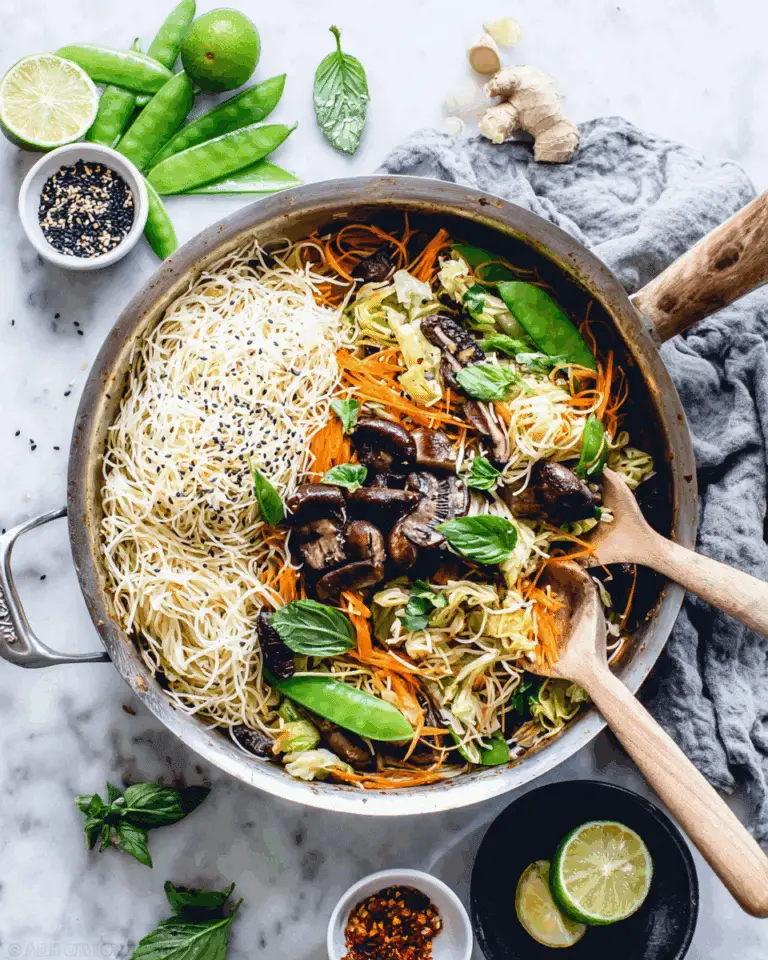
Thai Ginger and Garlic Noodle Bowl Recipe
A vibrant and flavorful Thai Ginger and Garlic Noodle Bowl featuring tender rice noodles, crisp snow peas, shiitake mushrooms, cabbage, and carrots stir-fried with fragrant ginger and garlic in a savory sesame-tamari sauce. Perfectly balanced with lime juice, fresh herbs, and a touch of heat, this dish is quick to prepare and makes a satisfying vegetarian meal.
- Total Time: 45 minutes
- Yield: 4 servings
Ingredients
Noodles
- 8 oz (227g) Rice Noodles or Bean Thread Noodles
Vegetables
- 11 oz (310g) Snow peas, trimmed
- 1 ½ cups (150g) Carrots, julienned (about two large carrots)
- 5 cups (400g) Green cabbage, cut into bite sized pieces (about ½ medium head)
- 5 oz (142g) Shiitake mushrooms, stemmed and sliced into quarters (cremini mushrooms can be used as substitute)
Sauce and Seasonings
- 1 ½ tbsp Sesame oil (divided, 1 ½ tbsp for stir-fry, 1 tbsp for sauce)
- 2 tsp Fresh ginger, microplaned
- 1 tbsp Fresh garlic, microplaned or minced
- ½ cup (110g) Vegetable broth
- 2 tbsp Tamari
- 1 tbsp Coconut sugar (or brown sugar or maple syrup)
- ½ tsp Red pepper flakes
- ½ tsp Sea salt
Garnishes
- Scallions, thinly sliced
- Sesame seeds
- Thai basil leaves (or mint and/or cilantro as alternatives)
- Lime wedges
- Drizzle of tamari and/or sesame oil
- Sriracha (optional, for serving)
Instructions
- Soak the Noodles: Place the rice noodles in a large bowl and cover them with cold water. Let them soak while you prepare the vegetables and sauce to soften without turning mushy.
- Blanch the Snow Peas: Bring a large stock pot filled half with water to a boil. Trim the ends of snow peas, then add them to the boiling water. Lower heat and blanch for exactly two minutes. Drain and immediately rinse with cold water to stop cooking. Return to the pot to keep warm off the heat.
- Prepare the Sauce: In a small jar, combine vegetable broth, 1 tablespoon sesame oil, tamari, coconut sugar, red pepper flakes, and sea salt. Secure the lid and shake well. Set aside.
- Stir-Fry Vegetables: Heat 1 ½ tablespoons sesame oil in a large skillet or wok over medium-high heat until shimmering. Add the grated ginger and garlic and sizzle for about 30 seconds to release aromas. Add mushrooms, cabbage, and carrots, and stir-fry using wooden spoons until vegetables are tender-crisp, about 5–6 minutes. Transfer these vegetables to the pot with the blanched snow peas (heat off) and set aside.
- Cook Noodles in Sauce: Drain the soaked noodles thoroughly and set near the stove. In the same skillet or wok, pour in the prepared sauce and bring it to a simmer. Gently add the noodles and use tongs to toss and coat them evenly with the sauce. Lower the heat and continue gently mixing the noodles in the sauce for about 2 minutes until tender but not soggy. Taste and cook for an additional minute if needed.
- Combine Noodles and Vegetables: Remove the skillet from heat and fold the stir-fried vegetables into the noodles. Use the residual heat to gently rewarm the vegetables. Squeeze in juice from half a lime and toss to combine. Adjust seasoning if needed.
- Garnish and Serve: Plate the noodle bowl and garnish with sliced scallions, sesame seeds, Thai basil leaves, and a drizzle of sesame oil and/or tamari. Serve with lime wedges and Sriracha on the side for added heat.
- Storage Tips: This dish is best enjoyed immediately as noodles can get soggy when reheated. Store leftovers in an airtight container in the refrigerator for up to three days. Freezing is not recommended as it affects texture.
Notes
- Use cold water soaking for rice noodles to prevent mushiness rather than hot soaking.
- Shiitake mushrooms can be replaced with cremini mushrooms for a similar texture and flavor.
- Adjust red pepper flakes to taste for desired spiciness.
- Vegetable broth can be homemade or store-bought, low sodium preferred for better control over salt.
- For a gluten-free version, ensure tamari is certified gluten-free.
- Use fresh herbs like Thai basil, mint, or cilantro to add aromatic freshness.
- Do not freeze the dish as noodles lose texture and become mushy upon thawing.
- Prep Time: 15 minutes
- Cook Time: 30 minutes
- Category: Main Course
- Method: Stovetop
- Cuisine: Thai
- Diet: Vegetarian


